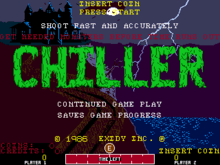Chiller (video game)
| Chiller | |
|---|---|
 | |
| Developer(s) | Exidy |
| Publisher(s) | Exidy, American Game Cartridges (NES - US), HES (NES - Australia) |
| Platform(s) | Arcade, Nintendo Entertainment System, |
| Release date(s) | 1986, 1990 (NES port), |
| Genre(s) | Light-gun games |
| Mode(s) | Up to 2 players, alternating turns |
| Cabinet | Upright |
| Arcade system | Exidy 440 CPU: |
| Display | Raster 320x240 resolution, Horizontal 256 colors |

Chiller is an Exidy light gun arcade game released in 1986. An unlicensed port was released for the Nintendo Entertainment System in 1990 by American Game Cartridges in the US, and in Australia by HES, with the option of using either the standard controller or the NES Zapper. The player takes on the role of an unseen torturer who must maim, mutilate, and murder helpless victims in a variety of dungeon settings. Few of the enemies in the game are capable of fighting back, with the challenge element lying in how quickly the player can cause each of the victims to die.
The game sold poorly in the United States because arcade owners refused to purchase it; Exidy did, however, find success in marketing it to third world countries.[1] Modern gamers often criticize the game for its senseless violence and encouraging the torture and murder of apparently innocent people, as opposed to the gamer fighting enemies capable of defending themselves.[2][3][4]
Overview
The game consists of a series of screens representing various dungeon and horror movie settings. Most screens feature helpless victims bound or restrained by a variety of medieval torture devices. The player must figure out how to kill every victim in as short amount a time as possible; although it is possible to simply shoot the victims to death, this process takes a considerable amount of time, as even headshots simply result in chunks of flesh and bone being blown away, leaving the victims alive. Rather, the challenge lies in finding ways to activate the various torture devices, resulting in quicker, bloodier deaths.
For each screen, shooting all available targets gives the player a bonus shooting round. The game features a Ghost counter on-screen scoring system named the "Ectoplasmic Tabulator". It has very similar gameplay to "Crossbow" and other related Exidy 440 board system games.
Arcade and NES game differences
- The NES version has a storyline that attempts to soften the implications of the violence by stating that all of the victims are actually monsters: "Back in the middle ages a castle on the outskirts of town has been invaded by an evil force which is causing the dead to come back to life! You need to stop this force before it can create a large army and take over the town. ...Each level also has 8 talismans hidden in it; you need to find and destroy these to stop the monsters from appearing."
- The horrific head seen in "Hallway" chasing a woman merely travels across the room in the NES version, while the Arcade's horrific head appearing from the end of the Hallway, coming quite close to the screen, then moving to the side, chasing the woman. This may have been because of the NES' lack of scaling features.
- The "items" used to play the bonus shooting stage in the arcade version are referred to as "Talismans"
- The levels are played in reverse to the video game:
Additionally, the NES version contained some minor censorship from the arcade version. This included removing the nudity on the female victim in the graveyard; removing the ability to shoot the flesh off of the rack victims; removing many of the body parts scattered around the torture room; and changing the monk pushing a cart of body parts to a nun pushing a baby carriage (although the nun can still be shot).
References
External links
- Chiller at MobyGames
- Chiller examined in detail on Ironic Consumer